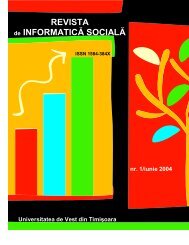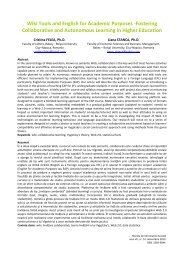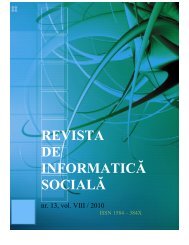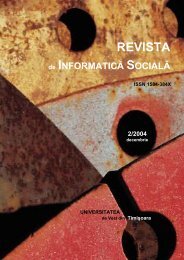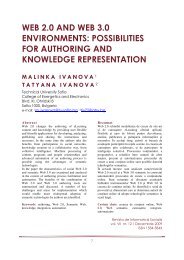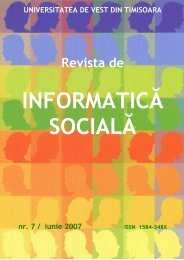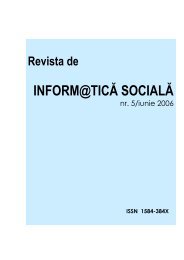Stage IV: Reducing the Total Cost <strong>of</strong> CompetenceInexorably, the affordability crisis will force learners and their families to search for bettervalue/options. And the presence <strong>of</strong> new, lower-price alternatives will enable potential learners toshop around and consi<strong>de</strong>r different options.Options that accelerate progress and thereby reduce the total cost <strong>of</strong> achieving the learner’sobjectives (be they a particular competence, certificate or <strong>de</strong>gree) are being <strong>of</strong>fered by manylearning provi<strong>de</strong>rs. These range from community colleges to major universities. Most <strong>of</strong> these donot transform faculty roles or business mo<strong>de</strong>ls, they just accelerate progress, but they <strong>de</strong>monstratethe concern about the total cost <strong>of</strong> completion. The University <strong>of</strong> Southern New Hampshire hasgained substantial recognition for its three-year programs, which it has been <strong>of</strong>fering for 13 years[8]. USNH estimates that 50 universities have accelerated three-year programs this year, with thenumber expected to jump to 100 in fall 2011. The University <strong>of</strong> Massachusetts Amherst has justlaunched a three-year track (which leverages high school AP <strong>of</strong>ferings) that will eventually beavailable to one-third <strong>of</strong> the university’s 88 majors [9].Another attractive approach to reducing the total cost <strong>of</strong> competence embraces the pathways,bridging, concurrent enrollment and “early college high school” programs being <strong>de</strong>veloped inpartnerships between high schools, community colleges and pubic universities across the nation.Almost every state has variations on these themes. For example, <strong>No</strong>rthern Virginia CommunityCollege and George Mason University have pathway programs in nursing and other selectedsubjects where stu<strong>de</strong>nts who get on the pathway can achieve a bachelor’s <strong>de</strong>gree in nursing threeyears after high school. Today, typical stu<strong>de</strong>nts may take six years – a year <strong>of</strong> remediation, a year <strong>of</strong>taking prerequisites that were missed, and then four years if everything goes well.Online provi<strong>de</strong>rs have one interesting advantage: since their relationship with learners is fullyonline. They can embed analytics, customer services, advising, success mentoring and otherservices into their relationship as a fundamental ingredient, not an add-on feature. So onlineprovi<strong>de</strong>rs will be driven to continue to re-invent their <strong>of</strong>ferings, enhancing their value propositionthrough a variety <strong>of</strong> practices: Compete on enjoyment - create better, more amenable and more effective, engaging learningand support experiences; Compete on outcomes - <strong>de</strong>monstrate that their programs are linked to highly valued,<strong>de</strong>monstrable competences and employability success; Compete on price - <strong>de</strong>crease tuition and fees, accelerate pace <strong>of</strong> completion and therebyreduce “total cost <strong>of</strong> competence”; Compete on time - reduce time to achieve competence objectives, certificates and <strong>de</strong>grees; Compete on flexibility - recognize credits from a wi<strong>de</strong>r range <strong>of</strong> institutions an<strong>de</strong>xperiences; and Compete on tracking change - provi<strong>de</strong> graduates with social-networking-based mechanismsfor refreshing and maintaining their competences on an ongoing basis.These conditions will affect the for-pr<strong>of</strong>its as well as traditional institutions. The reduction in timeto-<strong>de</strong>greewill be achieved in at least three ways: 1) giving credit for prior learning more effectivelyand extensively, 2) achieving competency-based approaches that unbundle and give credit foralready-acquired, <strong>de</strong>monstrated competences, and 3) improving K-12 preparation for college-levelwork through P-20 improvement initiatives and partnerships. These efforts can substantially reducethe total cost <strong>of</strong> learning, over time.A key factor in the price competition will be international competition. India- and China-basedprovi<strong>de</strong>rs have entered the online tutoring business for K-12 and postsecondary education. Theywill soon be a force in online learning, as well, through acquisitions and repurposing <strong>of</strong> institutionalprovi<strong>de</strong>rs in the US. Also, social networking-based learning <strong>of</strong>ferings from commercial provi<strong>de</strong>rs,
perhaps using Second Life-like virtual and augmented reality environments, may soon enter thescene at very competitive price points.New competitors will focus on particular points in the value chain that are un<strong>de</strong>rserved or can be<strong>of</strong>fered at a dramatically lower price.Summary <strong>of</strong> Stage IV: Reducing the Total Cost <strong>of</strong> CompetenceCharacteristics: Accelerated <strong>de</strong>gree completion, 3-year <strong>de</strong>grees. Pathway programs reachinginto high school. Full-featured focus on enjoyment, outcomes, price, time, flexibility andcapacity to track changes.Transformative Impact: Focus on value. Continue to reinvent the learner experience,changing roles, responsibilities.Impact on Institutional/Learner Costs: Reduce total cost <strong>of</strong> competence for the learner, in avariety <strong>of</strong> ways. Fast, fluid, flexible and affordable are the themes <strong>of</strong> the time.Exemplary Institutions/Participants University <strong>of</strong> Southern New Hampshire – three-year <strong>de</strong>gree (College Unbound), CollegeAdvantage Program – save 60% 100 Three-Year Degree Institutions by Fall 2011 (estimate) Capella University, others – credit for prior learning, reduced costs for <strong>de</strong>monstratedcompetences.Stage IV will be a time <strong>of</strong> accelerating competition and increased efforts by institutional provi<strong>de</strong>rsto <strong>de</strong>monstrate their adaptation and nimbleness in or<strong>de</strong>r to attract learners and <strong>of</strong>fer distinctive,superior value propositions. Increasingly, open learning practices will be incorporated intoinstitutional <strong>of</strong>ferings and accepted for credit if they involve “recognized” provi<strong>de</strong>rs (accreditedwith established articulation agreements). Fast, fluid, flexible and affordable will be the watchwords<strong>of</strong> the day. Institutions will focus on <strong>de</strong>veloping the infrastructure, support services, processes andreward systems necessary to support these efforts.Stage V: Success Maker, Certifier and Learning BrokerThe graphic illustrates that with each successive stage <strong>of</strong> evolution, institutional learning alsoexpands upward, embracing more open learning techniques within institutional/enterprise learningpractices.During Stage V, institutions will have incorporated open learning practices into their <strong>of</strong>ferings andwill accept and certify high-value outcomes provi<strong>de</strong>d by other institutions or new learningenterprises. In addition, selected lea<strong>de</strong>rs will have <strong>de</strong>veloped or acquired the capacity to certify freerangelearning and competence building pursued by individuals in<strong>de</strong>pen<strong>de</strong>nt <strong>of</strong> formal institutionsor to certify learning achieved by learners associated with new, low-cost provi<strong>de</strong>rs. In other cases,learning brokers/agents will aggregate <strong>of</strong>ferings from a variety <strong>of</strong> provi<strong>de</strong>rs. Adaptive learningenterprises will enhance their services in mentoring, advisement, and career guidance, hoping tobecome seen as “success makers.” Some enterprises will combine variations on all <strong>of</strong> these<strong>de</strong>velopments, opening up new services to learners.An interesting example <strong>of</strong> elements <strong>of</strong> this movement is the relationship between the companyStraighterLine, the American Council on Education (ACE) Transfer Credit Process, andparticipating universities. StraighterLine is a company that <strong>of</strong>fers online courses for $99 a month(entire freshman year for $999) and has been approved by the ACE Transfer Credit Process.Therefore, StraighterLine course are accepted by a long line <strong>of</strong> participating institutions, most <strong>of</strong>which are online or virtual universities or institutions with an online affiliate.
- Page 1: Revista de Informatica Sociala 14 /
- Page 7: ● ● ●CONTENTS● ● ●[9-20
- Page 10 and 11: THE TRANSITION FROM OLD TO NEW MEDI
- Page 12 and 13: 30252023.420.325.11510500.85.5Never
- Page 14 and 15: Overall, we can therefore sum up on
- Page 16 and 17: n.a.I often use itI seldom use it6.
- Page 18 and 19: - Traditional web use: searching th
- Page 20 and 21: 19. Kvavik R.B., Caruso J.B. and Mo
- Page 22: IntroductionIn 1995, Bernie Dodge o
- Page 25 and 26: The Web-Inquiry Project [WIP] is a
- Page 27 and 28: and even orally. The teacher will a
- Page 29 and 30: environment in which the teacher gu
- Page 31 and 32: Transformation Through Online Learn
- Page 33 and 34: INTRODUCTIONLeading practitioners a
- Page 35 and 36: learning. We also describe how the
- Page 37 and 38: Some of these transformations are b
- Page 39 and 40: Recently, Twigg has received suppor
- Page 41: Stage III: Unbundled Learning, Mark
- Page 45 and 46: performance. Indeed, Stage V will l
- Page 47 and 48: Free-Range Open LearningOver time,
- Page 49 and 50: New communities, tools and services
- Page 51 and 52: Embed enterprise-wide predictive an
- Page 53 and 54: In collaboration with Strategic Ini
- Page 55 and 56: Wiki Tools and English for Academic
- Page 57 and 58: eality. Besides being an additional
- Page 59 and 60: StudentPage 1StudentPage nTeacher
- Page 61 and 62: 100%90%80%70%60%50%40%30%20%10%0%Ac
- Page 63 and 64: 200Correlation View/Page Edits150Vi
- Page 65 and 66: 14. http://eacea.ec.europa.eu/llp/s
- Page 67 and 68: Simularea şi comunicarea electroni
- Page 69 and 70: RespondenţiRăspunsuriLa nivelul
- Page 71 and 72: RespondenţiRăspunsuriLa nivelul
- Page 73 and 74: Respondenţii au fost rugaţi să i
- Page 75 and 76: Itemul 9 doreşte să identifice ti
- Page 77 and 78: Identificara opţiunii, chiar şi p
- Page 79 and 80: EşantioaneRăspunsuri/Ranguriagita
- Page 81 and 82: modalităţile practice prin care u
- Page 83 and 84: 1. INTRODUCEREÎn prezent, complexi
- Page 85 and 86: Figura 1. Analiza grafică a evolu
- Page 87 and 88: Faţă de această situaţie se deg
- Page 89 and 90: variabilele acesti noi culturi cybe
- Page 91 and 92: INTRODUCEREÎncă din anul 2000 am
- Page 93 and 94:
după tipul lecţiei: prezentare de
- Page 95 and 96:
Funcţiile oferite de AEL asigură
- Page 97 and 98:
• elevi/studenţi, beneficiari di
- Page 99 and 100:
Se poate folosi cadrul formal de co
- Page 102 and 103:
Evaluarea formativă este comentari
- Page 104 and 105:
Rezultatele elevilor, pe itemi:Diag
- Page 106 and 107:
Nr. Denumirea activităţii AEL MOO
- Page 108 and 109:
SEMNAL EDITORIALLaura MALITA, Vanna
- Page 110:
IN MEMORIAMConstantin TraianCHEVERE




